Abstract
Fly ash (FA) is a low-cost industrial waste material mostly composed of oxides. These small, hard particles can be used as reinforcements in composite production. In this study, an A356.0 aluminum alloy reinforced with 4 wt.% FA was synthesized by compo casting and subsequently subjected to multiple passes of equal channel angular extrusion (ECAE) to investigate the influence of intense plastic deformation on the composite hardness and microstructure. Microstructure analysis was performed on an optical microscope and by computer tomography (CT). The as-cast alloy contains a relatively homogeneous microstructure with minor FA agglomerations and very low porosity. The severe plastic deformation induced by ECAE results in a directed structure and additional integration of FA into the matrix with the disappearance of pores. Vickers hardness measurement of aluminum/fly ash (Al/FA) composite was carried out with different indentation loads: 0.196 N (HV0.02), 0.490 N (HV0.05), 0.981 N (HV0.1), and 1.960 N (HV0.2). The results showed that hardness increases after each ECAE pass because of microstructure changes. Already after the first pass, a significant increase in hardness is achieved, ranging from 27% (HV0.05) to 62% (HV0.2). A Meyer’s index (n) value greater than 2 indicates that the hardness of single and double extruded composite depends on the indentation load. Extruded samples show a hardness enhancement with increasing applied load, so the examined composite exhibits a reverse indentation size effect (RISE).
1. Introduction
Fly ash (FA) is the main side product of coal combustion in thermal power plants, which appears at temperatures from 920 °C to 1700 °C and is collected in flue gas filters [1,2]. The properties and composition of fly ash vary depending on the origin and type of coal. Generally, it is a low-density material primarily composed of metal oxides. Due to the small diameter of the particles, from 1 µm to 250 µm, and the chemical composition itself, FA can lead to air pollution and problems with the respiratory system of people and animals, as well as soil and water pollution at dumps. Despite global energy policies advocating for alternative energy sources that minimize CO2 emissions and reduce dependence on fossil fuels, coal-fired power plants still represent 36.4% of energy sources worldwide [1]. In some countries, the situation is even more alarming; for example, over 70% of electricity in India is generated from coal-fired thermal power plants [3]. Fly ash constitutes 40% of the total industrial waste material in thermal power plants, with approximately 370 million tons produced annually globally [4]. India, China, and the United States are particularly significant contributors to these quantities [5,6,7]. Consequently, the disposal of FA poses a serious ecological and economic challenge.
Aluminum materials are utilized to produce lightweight components in the automotive industry and beyond. Their engineering applications benefit from an excellent strength-to-density ratio. To achieve optimal properties, such as high hardness, strength, rigidity, and resistance to wear and corrosion, an Al- or Al–alloy matrix can be reinforced with various metallic and non-metallic particles. Common reinforcements include carbides and oxides such as silicon carbide (SiC), aluminum oxide (Al2O3), and graphite [8]. Recent research has focused on using waste materials from other production processes, such as fly ash [1], rice husk ash [9], and red mud [10], as reinforcement.
The prices of individual reinforcements are high, ranging from USD 150/kg (Al2O3) to USD 500/kg (Si3N4 and B4C). In contrast, fly ash is a low-cost material at USD 0.05/kg to USD 00.1/kg, and it can also have a negative value, meaning that some companies pay for its proper disposal [4]. Using FA effectively in composite production can mitigate disposal issues. Fly ash contains a significant amount of Al2O3 and other high-cost hard particles, justifying its use as reinforcement [2,4]. Incorporating fly ash as a reinforcement in the aluminum matrix properties such as hardness, strength, and wear resistance can be improved while simultaneously reducing density [11].
The stir casting process is the commonly used method to produce metal matrix composites (MMCs). During this process, the reinforcement is added to the fully melted matrix while mixing. Compared to stir casting, compo casting is a method that mixes reinforcements in a semi-hardened matrix. This method enhances composite microstructure and reduces energy consumption [12,13].
The properties of compo casting produced composite can be further improved by applying plastic deformation processes. Plastic deformation processing alters a material’s microstructure. The greater intensity of plastic deformation results in more significant microstructural changes, known as processing with severe plastic deformation (SPD). One commercially applied SPD forming technique is equal channel angular extrusion (ECAE), also known as equal channel angular pressing (ECAP), in which simple shear stresses are used to change the microstructure and properties of the material, including hardness [14].
Although the compo casting process is cost-effective for producing MMC and results in a better composite microstructure than other casting processes, certain limitations exist. Some porosity in the manufactured MMCs, non-uniform distribution of reinforced particles, and problems with bonding the particles to the matrix (wettability) may occur. This can ultimately diminish the mechanical properties of the composite material, so it is essential to enhance it through a supplementary forming process that involves a significant amount of plastic strain [15,16]. Combining the compo casting process with equal channel angular extrusion is a good idea, and it is represented in this article. The main purpose of this study is to produce an aluminum/fly ash (Al/FA) composite with a uniform distribution of FA particles within the Al matrix with improving hardness. In addition, the dependence of the measured hardness on the applied load is analyzed by applying Mayer’s law.
2. Materials and Methods
A commercial casting alloy, A356.0, was used in the production of the composite. In addition to good castability, this Al-Si alloy has a good ratio of strength and density, which is why it is used for producing parts in the auto and aviation industries [17]. It has also been successfully used to make composites with FA in previous research [17,18,19,20,21]. The chemical composition of the alloy is given in Table 1.

Table 1.
The chemical composition of A356.0 alloy, wt.%.
It is important to highlight that, besides containing 7% silicon (Si), the alloy also includes 0.37% magnesium (Mg). The addition of magnesium (Mg) can enhance the wettability of the reinforcement particles and consequently improve bonding with the matrix [15].
The FA used as reinforcement is from the thermal power plant “Kolubara”, Veliki Crljeni, Serbia. Morphological characteristics and results of several analyses of the fine particle fraction have been previously reported [18,19,20,21]. The used FA was sieved (w = 63 µm; d = 45 µm, where w is the diagonal of the square opening of the sieve mesh and d is the length of each side of the square opening), and only fine particle fraction was examined and used for composite production. Inductively coupled plasma-optical emission spectroscopy (ICP-OES) analysis was performed to determine the composition of FA. However, the ICP-OES method cannot identify all the elements present because solvents are used. It is common knowledge that FA consists mainly of oxides. Therefore, the findings from the ICP-OES analysis have been calculated into oxide content, presented in Table 2.

Table 2.
The oxide content in fine particle fraction FA, wt.%.
The results indicate that in the analyzed sample of FA, the highest ratio of silicon oxide (SiO2) is 37.8 wt.%, while the fraction of aluminum oxide (Al2O3) is also a substantial 22.5 wt.%. The oxide content in the fine fly ash has been corrected for insoluble residue, resulting in 95.8 wt%. Additionally, the loss on ignition (LOI) measured at a temperature of 1000 °C was 1.6 wt.%.
To produce composites by compo casting method, 4 wt.% fine FA was added to the semi-solid aluminum alloy A356.0 as reinforcement. Composite samples were produced at the Vinča Institute of Nuclear Science, the National Institute of the Republic of Serbia, University of Belgrade. Figure 1 shows a schematic representation of this process. Electric heaters, marked as red circles, maintain the die temperature. The system must be equipped with a temperature sonde and auxiliary devices for precise temperature regulation.
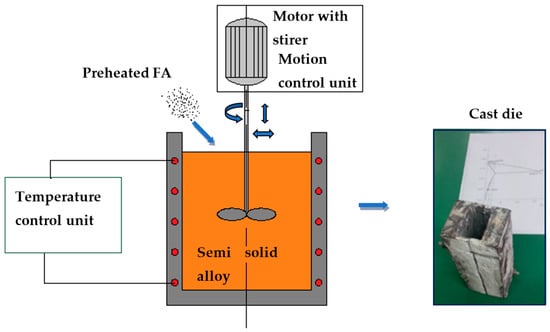
Figure 1.
Compo casting process schematic.
When the material is mixed into a semi-solid state due to shearing forces, dendritic growth is disrupted, as shown in Figure 2. This disruption results in the formation of both primitive and mature rosettes, as well as spheroidal particles, leading to an improved microstructure. When applied to composite production, this process enhances the distribution of reinforcements within the matrix and improves the wettability of the particles [15,16,17,18,19,20,21,22].
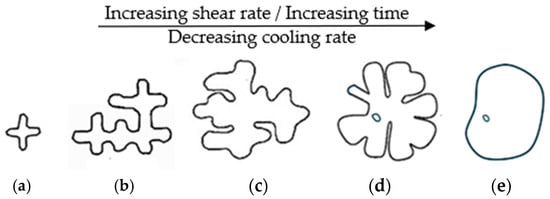
Figure 2.
Rheological formations in microstructure: (a) initial dendritic formation; (b) dendritic growth; (c) primitive rosette; (d) mature rosettes; (e) spheroids.
The parameters of the applied compo casting process were as follows:
- The FA was preheated at 150 °C for 2 h to eliminate moisture.
- The reinforcement is added gradually in the A356.0 matrix at a temperature of 610 °C while mixing at 600 rpm.
- The FA is mixed in the semi-solid matrix for 4 min before being poured into a die preheated to 300 °C.
- After casting, the two-part die with internal dimensions of 20 mm × 30 mm × 150 mm was left to cool gradually at room temperature along with the casting.
Samples dimensions 11.8 mm × 11.8 mm × 120 mm were cut from an ingot. These samples are suitable for extrusion through the square channel of the ECAE tool with a cross-section of 12.0 mm × 12.0 mm. After each pass, we had to align the edges to prepare the sample for the ECAE die (Figure 3).
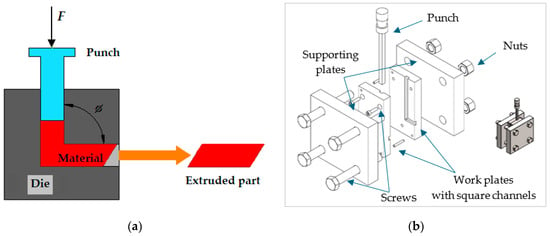
Figure 3.
The ECAE process: (a) schematic; (b) tool.
The procedure was performed using a hydraulic press, model “HYDRAUMA” (Hermann Grimm KG, Triebes, Germany), with a nominal force of 122 kN. The ECAE deformation process was carried out in two passes at room temperature and a speed of less than 0.02 m/s. Molybdenum disulphide was used as a lubricant to reduce friction. After the first pass, the samples were rotated around the longitudinal axis by 90°. Different ways of rotating, known as routes, intensely influence the microstructure and properties of the material [14,23,24,25].
After classic metallographic preparation that included final polishing with a diamond paste of 0.03 μm abrasive size, the samples’ microstructure was analyzed by an Olympus GX51 light microscope (Olympus, Tokyo, Japan). Average grain size was determined by the standard method according to ASTM E112-24 [26].
To investigate the impact of plastic deformation on the porosity of the composite, a computer tomography (CT) scan of the samples was conducted on a METROTOM 6 scout device (Carl Zeiss Industrielle Messtechnik, Oberkochen, Germany). Industrial CT device utilizes X-rays that pass through the object being examined and are detected by a radiation detector. The extent to which the X-rays are attenuated depends on the density of the materials they pass through. Based on the detected X-rays, the device produces an image in various shades of grey, where darker regions represent less dense materials.
In addition, standard Vickers hardness measurements for as-cast, single-extruded, and double-extruded states were performed on a PMT-3U4.2 (Touch Pribor, Moscow, Russia). Different indentation loads (F) were used: 0.196 N (HV0.02), 0.490 N (HV0.05), 0.981 N (HV0.1), and 1.960 N (HV0.2). Twenty measurements were taken for each applied force for a duration of 15 s. During the testing of hardness, the applied load can significantly influence the results. If a material endures a decrease in hardness with the increasing load, this is known as the normal indentation size effect (ISE). It is also possible that the material manifests an increase in hardness with the increasing indentation load; this phenomenon is called reverse ISE (RISE). Both phenomena are illustrated schematically in Figure 4.
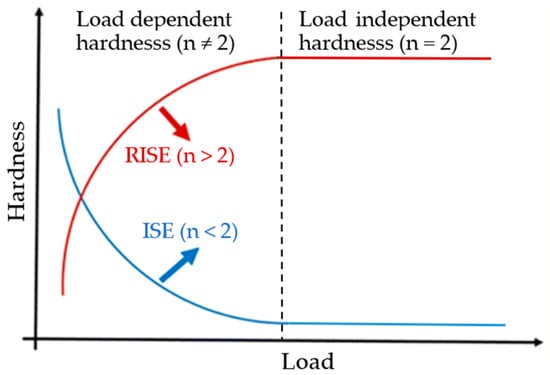
Figure 4.
Schematic plot of hardness variation with test load.
This manifested, non-constant hardness is often called “apparent” hardness, while the constant hardness, which usually occurs at higher indentation loads, is known as the “true” hardness or load-independent hardness. Relationships between the applied load, F, and the resulting indentation size, d, have been analyzed by the Mayer law [18,27,28,29,30]:
where n is the Meyer’s number (index), and K is the standard hardness constant (Nmm−n).
F = K·dn
Logarithmizing Equation (1) and placing the dependence of log F versus log d results in a linear trend of the form:
from which the values of n and K can be easily determined. For the case when n < 2, the material exhibits normal ISE, i.e., the hardness decreases with increasing applied load, while reverse ISE is characterized by n > 2 when the hardness increases with increasing applied load (Figure 4). If n = 2, the measured hardness values do not depend on the indentation load and represent the “true” hardness.
Y = n · x + logK
3. Results and Discussion
3.1. Density and Porosity
The density of as-cast and extruded composite samples was measured using the Archimedes principle on an analytical balance type JP703C (Mettler Toledo, Zürich, Switzerland). The relative density of the samples (ρrel) was calculated using the following equation:
where ρtheo is theoretical density. This density is determined by the inverse mixing rule:
where ρA = 2.67 g/cm3—aluminum alloy density, ρFA = 2.103 g/cm3—FA density, wA—weight ratio of aluminum alloy, and wFA—weight ratio of FA.
1/ρK = wA/ρA + wFA/ρFA
Measured, theoretical and relative density values of composite samples are shown in Table 3.

Table 3.
Measured, theoretical, relative densities and porosity of composite samples.
The porosity of the samples, expressed as a percentage, are derived from the following equation:
3.2. Light Microscopy
Figure 5 shows the composite microstructure of the A356.0 alloy containing 4 wt.% FA. The Figure presents the three states of composite: as-cast (Figure 5a), single-extruded (Figure 5b), and double-extruded (Figure 5c). The bright area represents the solid solution of silicon in aluminum, while the grey area indicates the eutectic composition, Figure 5a. In this Al-Si alloy, the eutectic consists of a mixture of α-Al crystals and needle-like silicon, as illustrated in enlarged detail in Figure 5a.
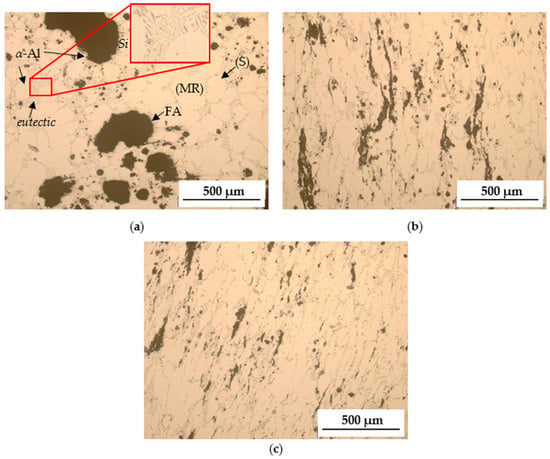
Figure 5.
Microstructure of the Al/FA composite: (a) as-cast; (b) single extruded; (c) double extruded (MRs)—mature rosettes; (Ss)—spheroids.
The as-cast composite has a changed dendritic structure with mature rosettes (MR) and spheroids (S). As a result of mixing in a semi-solid solution, FA remained trapped in the matrix; its floating did not occur. The FA is well integrated into the matrix, with no higher pores or voids observed. Although the reinforcement is generally evenly distributed over the surface, larger or smaller agglomerations can be noticed (dark area). The change in the microstructure of the extruded composite samples caused by deformation is visible. After undergoing angular extrusion, as presented in Figure 5b,c, the agglomerations of FA were broken up, resulting in a more even distribution of FA in the Al matrix. The structure becomes more compact and partially oriented in the direction of the shear planes/material moving.
The ECAE process deforms the Al/FA composite microstructure and reduces the grain size. In the as-cast state, the grain size of α-Al crystals was in the range of 65 µm–130 µm, once extruded 30 µm–65 µm and double extruded 30 µm–45 µm. Grain size significantly affects the strength of metals because grain boundaries make it difficult to slide dislocations. The effect of grain refinement is also known as Hall–Petch strengthening (ΔσHP) and can be estimated based on the equation [31,32]:
where k is a constant that depends on the material (k = 0.14 MPa∙m1/2 [32]) and d is the grain size. Considering the above-mentioned ranges of grain sizes, the values of strengthening after the first extrusion are in the interval:
ΔσHP = k · (d1−1/2 − d0−1/2)
- ΔσHP 0–1 = 5.09 MPa–8.20 MPa.
- The increase in strength caused by the second additional pass ranges from
- ΔσHP 1–2 = 0 MPa–3.50 MPa.
- Finally, the strengthening between the double extruded and as-cast state is
- ΔσHP 0–2 = 5.09 MPa–11.70 MPa.
For the reference yield strength of the commercial alloy A356.0 (Re = 190 MPa [33]), the strength increase between the as-cast and double extruded states is estimated to be 2.7–6.2%.
The strengthening values of the extruded Al/FA composite are certainly even higher in reality due to the fragmentation of the needle-like silicon and a more uniform distribution of the FA particles.
3.3. Computer Tomography
To evaluate the morphology and homogeneity of the obtained composites, computed tomography was conducted on individual samples before and after the extrusion forming (ECAE). This technique allows the scanning of materials in layers, including horizontal and vertical planes. As a result, multiple scans are taken; however, Figure 6, Figure 7, Figure 8, Figure 9, Figure 10 and Figure 11 presented below show only representative scans. Notice that the square grid is 1 mm × 1 mm, as indicated in the lower left corner in all Figures.
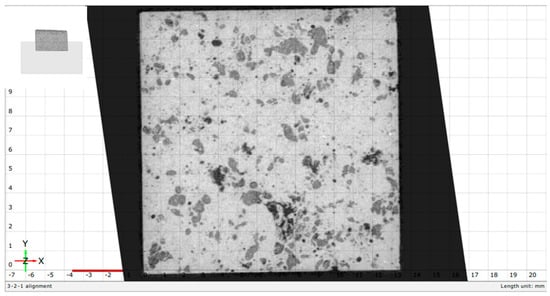
Figure 6.
CT scan of Al/FA composite in the as-cast state—horizontal section.
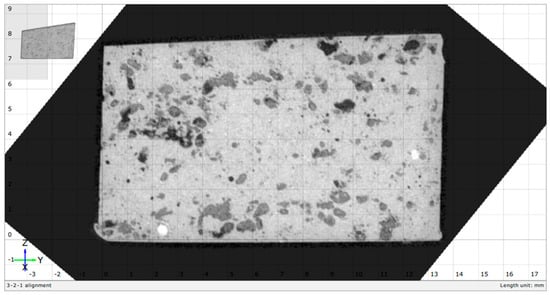
Figure 7.
CT scan of Al/FA composite in the as-cast state—vertical section.
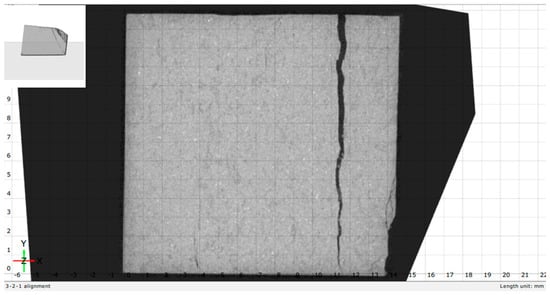
Figure 8.
CT scan of Al/FA composite after single ECAE—horizontal section.
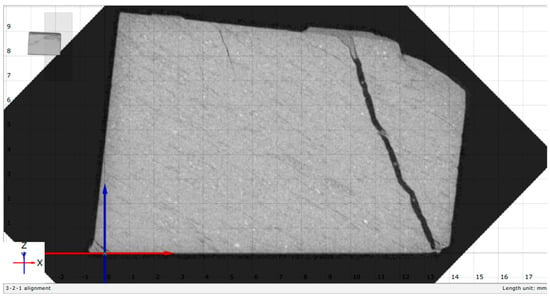
Figure 9.
CT scan of Al/FA composite after single ECAE—vertical section.
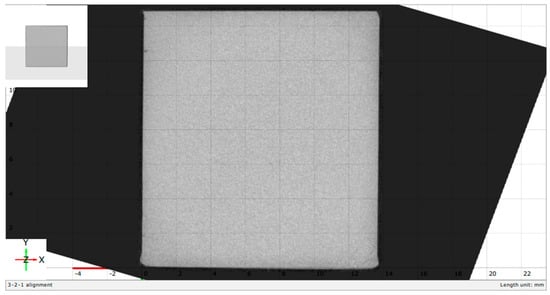
Figure 10.
CT scan of Al/FA composite after double ECAE—horizontal section.

Figure 11.
CT scan of Al/FA composite after double ECAE—vertical section.
Figure 6 and Figure 7 illustrate CT scans of the composite sample in an as-cast state. By applying the appropriate software (Image J, V 1.54k), it was estimated that the observed surfaces have about 1% pores that match with calculated value (0.91%). The light grey zones on CT scans represent the densest regions, which correspond to the Al matrix, while the darker grey areas indicate the fly ash. The FA is well distributed in both horizontal and vertical planes, although smaller agglomerations are present. The completely black zones signify empty spaces or pores, while the small, extremely bright areas—appearing almost white—correspond to higher-density fractions. It can be inferred that these bright surfaces are iron compounds found in the FA. Overall, there is no significant difference between the horizontal and vertical layers.
Figure 8 and Figure 9 show the CT scans of the sample after the first ECAE pass at different cross-sections of the sample. There is quite a visible difference between the horizontal and vertical sections. FA (dark grey) is better distributed inside the matrix, and in the vertical plane, it finely maintains the shear planes, i.e., the direction of movement of the material during ECAE. As a result of intensive plastic deformation, pores and FA agglomerates disappeared, which is confirmed by Image J software analysis and by calculating the density and porosity of samples. The figures are dominated by a crack that follows the shape of the fracture surface formed by the cracking of the sample tip due to intense plastic deformation during extrusion forming, presented in the upper left corner.
Figure 10 and Figure 11 show the sample after the second ECAE pass. There is no difference in the microstructure Al/FA composite on the horizontal and vertical sections that can be observed. It is obvious that an utterly homogeneous microstructure is obtained after the second extrusion.
Due to severe plastic deformation forces, a small sample piece also broke off during this test, so minor cracks are visible in Figure 11. Although this research did not focus on preventing cracks in composites caused by severe plastic deformation correctly optimizing ECAE parameters, they can be avoided.
3.4. Vickers Hardness Test
The results of the hardness measurement for the A356.0 + 4 wt.% FA composite are given in Table 4.

Table 4.
Values of Vickers hardness (x-arithmetic mean of twenty repeated measurements; xmin, xmax-minimum and maximum value; SD—standard deviation).
Measured hardness values highly depend on whether the indenter will imprint in α-Al, eutectic, or FA, resulting in different hardness values and their greater or lesser scattering, especially at lower loads, which was to be expected. The appearance of cracks and directionality of the microstructure, both caused by plastic deformation, also impact the deviation of the results. Therefore, the highest standard deviation of 13 HV was recorded at the lowest force of 0.196 N (HV0.02) for the sample that was extruded once.
Figure 12 shows the dependence of the hardness on the degree of deformation determined by imprinting the Vickers pyramid with different loads. All data are averages of twenty values; therefore, different coloured error bars were plotted. There is an evident increase in hardness after ECAE compared to the as-cast state. At all applied loads, it is visible that after the first pass, a more significant increase in hardness was achieved. Hardness values increased from 27% (HV0.05) up to 62% (HV0.2), with a decrease in SD at the highest indentation force. In the second extrusion pass, the increase in hardness is somewhat slower and amounts to 0%, 10%, 16%, and 19%, respectively, for applied loads ranging from 0.196 N to 1.960 N. For the examined Al/FA composite, the most significant total increase in hardness of 93.7% was noted between the as-cast and the twice-extruded sample at the highest test load of 1.960 N. Considering the measured values shown in Table 3 and Figure 12, it can be concluded that the ECAE process had a strong effect on the hardness of the Al/FA composite.
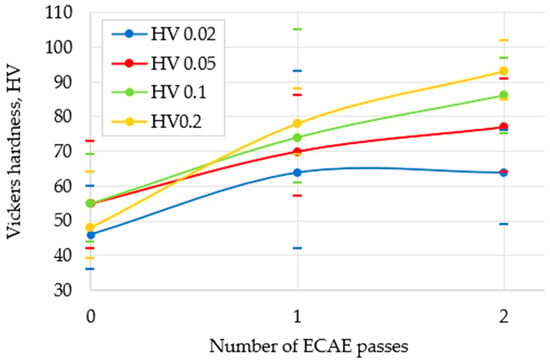
Figure 12.
The influence of the deformation degree on the hardness of Al/FA composite.
Figure 13 (left) presents the dependence of hardness on the applied indentation load F. Every measurement result is marked with different colours, and the bigger blue dots represent arithmetical mean values. The results show variations in measured hardness with the applied load. Figure 13 also includes the results of linear regression according to Meyer’s law (right) for different states investigated Al/FA composite: as-cast, single ECAE, and double ECAE. Single and double extruded samples show an enhancement in hardness with increasing the indentation load. The Meyer’s index values determined by linear regression for these states are 2.1952 and 2.3966. Values of n greater than 2 indicate that these states undergo reverse ISE. That means that hardness increases with the increase in the indenter load. The Meyer’s coefficient is also increased with the deformation degree. One can presume that the RISE results from material hardening caused by plastic deformation [29,30]. Since the ECAE process was performed in a cold state, residual stress in the material is certain, which could also have affected the results. The high value of the coefficients of determination (R2) from 0.9907 to 0.9999 confirms that Meyer’s law adequately describes the investigated phenomenon.
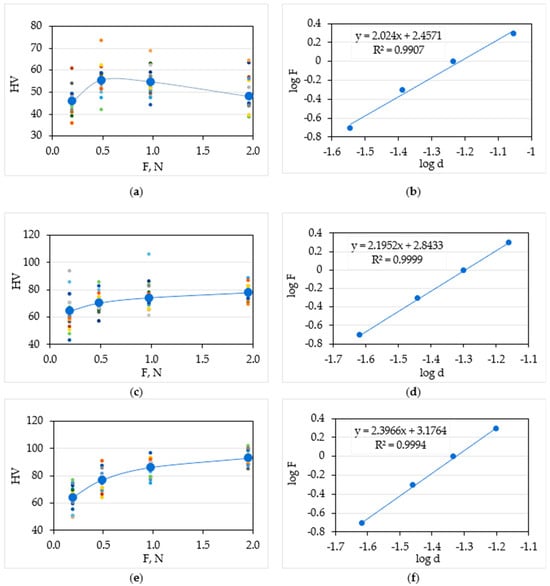
Figure 13.
Values of hardness as a function of indentation load (left) and graphical presentation of the dependence of log F on log d according to Meyer’s law (right) for different states Al/FA composite: as-cast (a,b); single extruded (c,d); double extruded (e,f).
4. Conclusions
Fly ash that contains mostly silicon and hard aluminum oxides was used as reinforcing particles in the production of metal composites. An aluminum matrix composite reinforced with 4 wt.% fly ash was successfully synthesized by the compo casting process and subjected to multiple extrusions.
Based on the results of the study, it is possible to draw the following conclusions:
- The aluminum matrix microstructure contains dendritic formations of α-Al crystals that have the form of primary and mature rosettes and completely spheroidal forms. The fine particle fraction FA is well distributed in the matrix. The microstructure is relatively homogeneous, with smaller FA agglomerations and very low porosity (less than 1%), and the application of the compo casting technique is fully justified.
- The subsequent ECAE process improves the composite’s microstructure. The severe plastic deformation due to intense shearing forces results in a directed structure and additional integration of FA into the matrix. The pores disappear after the first pass so that a fully monolithic, non-porous microstructure is formed by double extrusion.
- The combination of intense compression and shearing in different planes due to the workpiece’s rotation results in an increase in hardness with an enhancement in the intensity of deformation induced by multiple extrusion passes.
- A high coefficient of determination (from 0.9907 to 0.9999) indicates good agreement of hardness results with Meyer’s law. According to this law, extruded composites exhibit the reverse indentation size effect—RISE, i.e., an increase in hardness at higher indentation loads.
Further research should be focused on the following: creating composites with a higher FA content, optimizing ECAE process parameters, and considering other mechanical properties such as yield strength and tensile strength.
Author Contributions
Conceptualization, M.M. and V.R.; methodology, M.M.; software, M.M.; validation, M.M., V.R. and V.M.; formal analysis, M.M.; investigation, M.M.; resources, D.Ć.; data curation, D.Ć.; writing—original draft preparation, M.M.; writing—review and editing, V.R., V.M. and D.Ć.; visualization, M.M.; supervision, V.R., V.M. and D.Ć.; project administration, V.R.; funding acquisition, V.R., V.M. and D.Ć. All authors have read and agreed to the published version of the manuscript.
Funding
This research received no external funding.
Data Availability Statement
The original contributions presented in the study are included in the article, further inquiries can be directed to the corresponding author.
Acknowledgments
This research was partially supported by the Federal Ministry of Education and Science, Bosnia and Herzegovina.
Conflicts of Interest
Author Merima Muslić was employed by the E-PRO Ltd. for Design, Engineering, and Technical Consulting. The remaining authors declare that the research was conducted in the absence of any commercial or financial relationships that could be construed as a potential conflict of interest.
References
- Razzaq, A.M.; Majid, D.L.; Basheer, U.M.; Aljibori, H.S.S. Research Summary on the Processing, Mechanical and Tribological Properties of Aluminium Matrix Composites as Effected by Fly Ash Reinforcement. Crystals 2021, 11, 1212. [Google Scholar] [CrossRef]
- Seham, S.A.; Narguess, H.M. Fly ash properties, characterization, and applications: A review. J. King Saud Univ.—Sci. 2021, 33, 101536. [Google Scholar] [CrossRef]
- Chakravarty, S.; Somanathan, E. There is no economic case for new coal plants in India. World Dev. Perspect. 2021, 24, 100373. [Google Scholar] [CrossRef]
- Kasar, A.K.; Gupta, N.; Rohatgi, P.K.; Menezes, P.L. A Brief Review of Fly Ash as Reinforcement for Composites with Improved Mechanical and Tribological Properties. JOM 2020, 2340–2351. [Google Scholar] [CrossRef]
- Dwivedi, A.; Jain, M.K. Fly Ash-Waste Management and Overview: A Review. Recent Res. Sci. Technol. 2014, 6, 30–35. [Google Scholar]
- Kurda, R.; Silvestre, J.D.; de Brito, J. Toxicity and Environmental and Economic Performance of Fly Ash and Recycled Concrete Aggregates Use in Concrete: A Review. Heliyon 2018, 4, 611. [Google Scholar] [CrossRef]
- Mushtaq, F.; Zahid, M.; Bhatti, I.A.; Nasir, S.; Hussain, T. Possible applications of coal fly ash in wastewater treatment. J. Environ. Manag. 2019, 240, 27–46. [Google Scholar] [CrossRef]
- Verma, V.; Khvan, A. Advances in Composite Materials Development; Lucan, D., Ed.; IntechOpen: London, UK, 2019; Chapter 3. [Google Scholar]
- Mishra, P.; Mishra, P.; Rana, R.S. Effect of Rice Husk Ash Reinforcements on Mechanical Properties of Aluminium Alloy (LM6) Matrix Composites. Mater. Today Proc. 2018, 5, 6018–6022. [Google Scholar] [CrossRef]
- Geetha, B.; Ganesan, K. Optimization of Tensile Characteristics of Al 356 Alloy Reinforced with Volume Fraction of Red Mud Metal Matrix Composite. Procedia Eng. 2014, 97, 614–624. [Google Scholar] [CrossRef]
- Choudhury, A.; Nanda, J.; Das, S.N. Enactment of Aluminium-Fly Ash Composites. J. Phys. Conf. Ser. 2020, 1706, 012138. [Google Scholar] [CrossRef]
- Ramanathan, A.; Krishnan, P.K.; Muraliraja, R. A Review on the Production of Metal Matrix Composites through Stir Casting—Furnace Design, Properties, Challenges, and Research Opportunities. J. Manuf. Process. 2019, 42, 213–245. [Google Scholar] [CrossRef]
- Sharma, A.K.; Bhandari, R.; Pinca-Bretotean, C. A Systematic Overview on Fabrication Aspects and Methods of Aluminum Metal Matrix Composites. Mater. Today Proc. 2021, 45, 4133–4138. [Google Scholar] [CrossRef]
- Segal, V. Equal-Channel Angular Extrusion (ECAE): From a Laboratory Curiosity to an Industrial Technology. Metals 2020, 10, 244. [Google Scholar] [CrossRef]
- Malaki, M.; Tehrani, A.F.; Niroumand, B.; Gupta, M. Wettability in Metal Matrix Composites. Metals 2021, 11, 1034. [Google Scholar] [CrossRef]
- Saito, Y.; Utsunomiya, H.; Tsuji, N.; Sakai, T. Novel Ultra-High Straining Process for Bulk Materials—Development of the Accumulative Roll-Bonding (ARB) Process. Acta Mater. 1999, 47, 579–583. [Google Scholar] [CrossRef]
- Dwivedi, S.P.; Sharma, S.; Mishra, K.R. A356 Aluminum Alloy and Applications—A Review. Int. J. Adv. Mater. Manuf. Charact. 2014, 4, 81–86. [Google Scholar] [CrossRef]
- Muslić, M.; Orešković, L.; Rede, V.; Maksimović, V. Indentation Size Effect of Composite A356 + 6%FA Subjected to ECAP. Metals 2022, 12, 821. [Google Scholar] [CrossRef]
- Muslić, M.; Rede, V.; Maksimović, V. Solid Particle Erosion Resistance of al Alloy and al Alloy-Fly Ash Composite Subjected to Equal-Channel Angular Pressing. Metall. Mater. Eng. 2021, 27, 15–26. [Google Scholar] [CrossRef]
- Maksimović, V.M.; Devečerski, A.B.; Došen, A.; Bobić, I.; Erić, M.D.; Volkov-Husović, T. Comparative Study on Cavitation Erosion Resistance of A356 Alloy and A356FA5 Composite. Trans. Indian Inst. Met. 2017, 70, 97–105. [Google Scholar] [CrossRef]
- Narendranath, S.; Chakradhar, D. Studies on microstructure and mechanical characteristics of as cast AA6061/SiC/fly ash hybrid AMCs produced by stir casting. Mater. Today Proc. 2020, 20, A1–A5. [Google Scholar] [CrossRef]
- Pola, A.; Tocci, M.; Kapranos, P. Microstructure and Properties of Semi-Solid Aluminum Alloys: A Literature Review. Metals 2018, 8, 181. [Google Scholar] [CrossRef]
- Abdi, M.; Ebrahimi, R. Twin Parallel Channel Angular Extrusion as a Development of ECAE in Parallel Channels. SN Appl. Sci. 2020, 2, 548. [Google Scholar] [CrossRef]
- Frint, P.; Martin Franz, W.W. Strain partitioning by recurrent shear localization during equal-channel angular pressing of an AA6060 aluminum alloy. Acta Mater. 2019, 176, 306–317. [Google Scholar] [CrossRef]
- Skrotzki, W. Deformation Heterogeneities in Equal Channel Angular Pressing. Mater. Trans. 2019, 60, 1331–1343. [Google Scholar] [CrossRef]
- ASTM E112-24; Standard Test Methods for Determining Average Grain Size. ASTM International: West Conshohocken, PA, USA, 2004.
- Majić Renjo, M.; Ćurković, L.; Štefančić, S.; Ćorić, D. Indentation Size Effect of Y-TZP Dental Ceramics. Dent. Mater. 2014, 30, e371–e376. [Google Scholar] [CrossRef]
- Petrík, J.; Blaško, P.; Markulík, Š.; Šolc, M.; Palfy, P. The Indentation Size Effect (ISE) of Metals. Crystals 2022, 12, 795. [Google Scholar] [CrossRef]
- Blaško, P.; Petrík, J.; Šolc, M.; Mihaliková, M.; Girmanová, L.; Trpčevská, J. The Influence of the Degree of Tension and Compression of Copper on the Indentation Size Effect (ISE). Crystals 2024, 14, 913. [Google Scholar] [CrossRef]
- Petrík, J.; Blaško, P.; Petryshynets, I.; Mihaliková, M.; Pribulová, A.; Futáš, P. The Influence of the Degree of Tension and Compression of Aluminum on the Indentation Size Effect (ISE). Metals 2022, 12, 2063. [Google Scholar] [CrossRef]
- Maddaiah, K.C.; Kumar, G.B.V.; Pramod, R. Studies on the Mechanical, Strengthening Mechanisms and Tribological Characteristics of AA7150-Al2O3 Nano-Metal Matrix Composites. J. Compos. Sci. 2024, 8, 97. [Google Scholar] [CrossRef]
- Shanmugasundaram, T.; Heilmaier, M.; Murty, B.; Vadlamani, S.S. On the Estimation of True Hall–Petch Constants and Their Role on the Superposition Law Exponent in Al Alloys. Adv. Eng. Mater. 2012, 14, 892–897. [Google Scholar] [CrossRef]
- Dang, B.; Zhang, X.; Chen, Y.; Chen, C.X.; Wang, H.T.; Liu, F. Breaking through the strength-ductility trade-off dilemma in an Al-Si-based casting alloy. Sci. Rep. 2016, 6, 30874. [Google Scholar] [CrossRef] [PubMed]
Disclaimer/Publisher’s Note: The statements, opinions and data contained in all publications are solely those of the individual author(s) and contributor(s) and not of MDPI and/or the editor(s). MDPI and/or the editor(s) disclaim responsibility for any injury to people or property resulting from any ideas, methods, instructions or products referred to in the content. |
© 2025 by the authors. Licensee MDPI, Basel, Switzerland. This article is an open access article distributed under the terms and conditions of the Creative Commons Attribution (CC BY) license (https://creativecommons.org/licenses/by/4.0/).